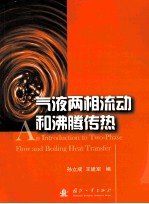

气液两相流动和沸腾传热 英文PDF电子书下载
- 电子书积分:9 积分如何计算积分?
- 作 者:孙立成,王建军编
- 出 版 社:北京:国防工业出版社
- 出版年份:2014
- ISBN:9787118094312
- 页数:168 页
Chapter 1 Introduction 1
1.1 What is Two-Phase Flow 1
1.2 Methods of Analysis 2
1.3 Notation 3
Chapter 2 Flow Pattern and Flow Pattern Map 6
2.1 Introduction 6
2.2 Flow Patterns in Vertical Flows 6
2.2.1 Flow patterns in vertical co-current flow 6
2.2.2 Flow patterns in vertical heated channels 8
2.3 Flow Patterns in Horizontal Flows 10
2.3.1 Flow patterns in horizontal co-current flow 10
2.3.2 Flow patterns in horizontal heated channel 12
2.4 Flow Pattern Maps and Transitions 12
2.4.1 Typical flow pattern maps 13
2.4.2 Criteria for flow pattern transitions 15
2.5 Flow Patterns in Other Applications 17
Chapter 3 Basic Models 18
3.1 Introduction 18
3.2 Drift Flux Model 19
3.3 Two-Fluid Model 20
3.4 Homogeneous Model 22
3.4.1 Conservation of mass 23
3.4.2 Conservation of momentum 24
3.4.3 Conservation of energy 25
3.5 Separated Flow Model 27
3.6 Overview 27
Chapter 4 Empirical Methods for Pressure Drop 28
4.1 Introduction 28
4.2 Correlations Based on the Homogeneous Model 28
4.3 Correlations Based on the Separated Flow Model 31
4.3.1 Correlations from momentum balance 31
4.3.2 Use of model to evaluate pressure loss 33
4.3.3 Determination of the two-phase multiplier 33
4.4 Pressure Losses Through Enlargements,Contractions,Orifices,Bends,and Valves 40
4.4.1 Sudden enlargement 41
4.4.2 Sudden contraction 43
4.4.3 Orifices 43
4.5 Annular Flow 45
4.6 Void Fraction 46
4.6.1 Homogeneous model 47
4.6.2 Drift-flux model 47
4.6.3 The Bankoff variable density model 49
4.6.4 The Hughmark correlation 50
4.7 Conclusions 51
Chapter 5 Two-Phase Critical Flow 52
5.1 Introduction 52
5.2 Theoretical Foundations 53
5.3 Critical Flow in Long Pipes 55
5.4 Critical Flow in Short Pipes,Nozzles and Orifices 59
5.5 Propagation of Pressure Pulses and Waves 63
Chapter 6 Introduction to Hydrodynamic Instability 64
6.1 Introduction 64
6.2 Classifications of Two-Phase Flow Instabilities 65
6.3 Physical Mechanisms of Static Instabilities 67
6.3.1 Fundamental static instability 67
6.3.2 Fundamental relaxation instability 71
6.3.3 Compound relaxationinstability 71
6.4 Physical Mechanisms of Dynamic Instabilities 73
6.4.1 Fundamental dynamic instability 73
6.4.2 Acoustic instability 74
6.4.3 Density-wave oscillations 75
6.4.4 Pressure-drop oscillations 76
6.4.5 Condensing instability 78
6.4.6 Thermal oscillations 78
6.4.7 Boiling water reactor instability 79
6.4.8 Parallel channel instability 80
6.5 Approaches in Two-Phase Flow Stability Analysis 80
6.5.1 Direct numerical analysis 81
6.5.2 Frequency-domain analysis 81
6.6 Situations Where Instability Arise 82
6.7 The Designer's Requirements 83
6.8 Problems Arising in the Application of Models and Tests to Designs 84
Chapter 7 Introduction to Nucleation in Boiling 86
7.1 Vapor-Liquid Equilibrium 86
7.1.1 Equilibrium criterion 86
7.1.2 P-v-T diagram 86
7.1.3 Equation of state 87
7.1.4 Metastable state 88
7.1.5 Clausius-Clapeyron equation 89
7.1.6 Thermodynamic equilibrium at a curved interface 90
7.2 Homogeneous Nucleation 92
7.2.1 Equilibrium condition for a embryo bubble 93
7.2.2 Mechanism of nucleation 94
7.3 Heterogeneous Nucleation 95
7.3.1 Contact angle and wettability 95
7.3.2 Nucleation at solid surfaces 97
7.3.3 Nucleation from entrapped gas or vapor in cavities 99
7.3.4 Size Range of Active Nucleation Sites 101
7.4 Bubble Dynamics 102
7.4.1 Bubble growth in an extensive liquid pool 103
7.4.2 Bubble growth near heated surfaces 107
7.4.3 Diameter and frequency of Bubble departure 110
Chapter 8 Pool Boiling 114
8.1 Nukiyama Boiling Curve 114
8.2 Regimes of Pool Boiling 116
8.3 Nucleate Boiling 120
8.3.1 Inception of boiling(Onset of Nucleate Boiling) 120
8.3.2 Heat transfer mechanisms in nucleate boiling 123
8.3.3 Nucleate Pool Boiling Correlations 125
8.4 Departure From Nucleate Pool Boiling 128
8.4.1 Transitional boiling regime and Taylor instability 128
8.4.2 Helmhohtz instability of vapor jets 130
8.4.3 Prediction of critical heat flux 131
8.5 Film Boiling 133
8.6 Minimum Heat Flux 134
Chapter 9 Flow Boiling 135
9.1 Regimes of Convective Boiling in Tubes 135
9.2 Onset of Boiling in Internal Flows 140
9.3 Subcooled Flow Boiling 143
9.3.1 Regimes of subcooled flow boiling 143
9.3.2 Methods of predicting partial subcooled flow boiling heat transfer 144
9.3.3 Void fraction and pressure drop in subcooled boiling 147
9.4 Saturated Flow Boiling 152
9.4.1 Regimes of saturated flow boiling 152
9.4.2 Heat transfer correlations for saturated flow boiling 153
9.5 Critical Heat Flux in Flow Boiling 157
9.5.1 Mechanisms 157
9.5.2 Prediction of CHF in flow boiling 159
References 167
- 《高超声速流动中的激波及相互作用》杨基明,李祝飞,朱雨建,张恩来,王军编者 2019
- 《流体力学与传热学》潘小勇编著 2019
- 《沸腾的群山》吴富佳,蔡国栋编绘 2019
- 《经济学前沿译丛 银行流动性创造与金融危机》艾伦·N.伯格,克里斯塔·H.S.鲍 2019
- 《四川流动劳动力的城市适应研究》刘伟 2018
- 《滑油在整体针翅管冷却器流动特性研究》牛广林著 2014
- 《梵高 一种力量在沸腾》(英)朱利安·贝尔著 2020
- 《流动的时光 龚琳娜老锣24节气古诗词歌曲》老锣 2019
- 《亚洲新兴经济体国际资本流动管理研究》 2017
- 《农业政策、收入流动性与农村经济发展研究》李明桥著 2018
- 《东方杂志 第110册 第25卷 第一至四号 1928年1月-1928年2月》上海书店出版社编 2012
- 《清明 我们的节日》冯骥才编 2017
- 《现代水泥技术发展与应用论文集》天津水泥工业设计研究院有限公司编 2019
- 《甘肃省档案馆指南》甘肃省档案馆编 2018
- 《莼江曲谱 2 中国昆曲博物馆藏稀见昆剧手抄曲谱汇编之一》郭腊梅主编;孙伊婷副主编;孙文明,孙伊婷编委;中国昆曲博物馆编 2018
- 《花时间 我的第一堂花艺课 插花基础技法篇》(日)花时间编辑部编;陈洁责编;冯莹莹译 2020
- 《中央财政支持提升专业服务产业发展能力项目水利工程专业课程建设成果 设施农业工程技术》赵英编 2018
- 《东方杂志 第94册 第22卷 第四至七号 1925年2月-1925年4月》上海书店出版社编 2012
- 《远去的老调》经典文库编委会编 2019
- 《东方杂志 第13册 第四年 第一至三期 1907年3月-1907年5月》上海书店出版社编 2012
- 《指向核心素养 北京十一学校名师教学设计 英语 七年级 上 配人教版》周志英总主编 2019
- 《北京生态环境保护》《北京环境保护丛书》编委会编著 2018
- 《指向核心素养 北京十一学校名师教学设计 英语 九年级 上 配人教版》周志英总主编 2019
- 《抗战三部曲 国防诗歌集》蒲风著 1937
- 《高等院校旅游专业系列教材 旅游企业岗位培训系列教材 新编北京导游英语》杨昆,鄢莉,谭明华 2019
- 《中国十大出版家》王震,贺越明著 1991
- 《近代民营出版机构的英语函授教育 以“商务、中华、开明”函授学校为个案 1915年-1946年版》丁伟 2017
- 《新工业时代 世界级工业家张毓强和他的“新石头记”》秦朔 2019
- 《智能制造高技能人才培养规划丛书 ABB工业机器人虚拟仿真教程》(中国)工控帮教研组 2019
- 《陶瓷工业节能减排技术丛书 陶瓷工业节能减排与污染综合治理》罗民华著 2017
